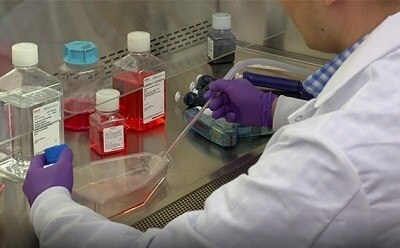Cultivate Consistency
Thousands of tools and reagents for reproducible cell culture

Cell culture is fundamental to life science research in universities, biotechnology, pharmaceuticals, and industry. Cells isolated from animal and human tissues in both 2D and 3D environments are used by researchers to study cell biology, treat diseases, and produce antibodies, proteins, and vaccines.
We have everything you need to keep your tissue culture room thriving so you can accomplish your goals, establish relevant cell models, and answer your research questions. Our complete portfolio of cell lines, cultureware, media, supplements, and assay kits offer a variety of choices for every application.

Prepare Your Projects
Preparing for your cell culture application requires the right culture tools and equipment to help you obtain reliable and reproducible data. When preparing for your project, deciding which cell line is ideal for their application or research question and which cultureware is important.
We offer a carefully curated, diverse selection of mammalian, stem, primary, and cancer cell lines, patient-derived organoids, and organoid culture systems and specialty cultureware, including membrane-based inserts and plates so you can best prepare for your cell culture workflow.
Grow and Thrive
A necessary and important step in the cell culture workflow, growing, monitoring, and testing cells often requires supplementing tissue culture media and buffers. While growing their cells, researchers focus on helping cells thrive in their environment.
We offer cell culture-tested media, sera, and reagents that undergo validation in relevant culture systems including 3D environments. Our products help researchers provide the appropriate environment for healthy propagation of any cell phenotype or application. Choose the ideal culture supplement to create a unique and reliable environment for your cultures.

Analyze Accurately
Cell analysis and cell-based assays allow researchers to understand and quantify cell health and function. To analyze their cell cultures, researchers need state-of-the-art assays and reagents, regardless of their application or project objectives.
From mycoplasma detection to live cell imaging dyes and reagents, our wide range of cellular tools will help you analyze cellular processes and monitor cell health. Discover the ideal cellular assay and tool for your application.

Troubleshoot Your Cultures
Cell culture is an essential technique for modeling biological systems in life science research and pharmaceutical labs. Though this technique is highly accessible, successful propagation of cells for stock expansion or modeling experiments can be plagued by conditions that negatively impact cell growth and viability.
We provide technical expertise to help researchers throughout the cell culture workflow. Learn how to identify and troubleshoot common cell culture problems, ensuring meaningful, reliable, and reproducible downstream data from in vitro models.
Which Bottles are Compatible with the Stericup® E and Stericup® E Filtration Systems?
Here we demonstrate how to use Stericup® E sterile filtration device for filtering and storing tissue culture media. Learn which media bottles are compatible with the Stericup® E filtration unit to use in your cell culture application.
Live Cell Imaging of Apoptosis in Immune Cells
Time lapse imaging of Jurkat cells using the CellASIC® ONIX2 System and M04T Pad Trap Plate. Imaging was taken at 10 minute intervals under 400x magnification using a FITC and Texas-Red filter to visualize Caspase 3 activation and Annexin binding.
Increase Lab Productivity with the Millicell® DCI Digital Cell Imager
Assess common cell culture parameters confluency, cell count, and morphology with the Millicell® DCI Digital Cell Imager. Learn how to simplify culture analysis, reduce user bias, and store your accurate results with the web-based cloud service for data storage.
How to Thaw Cells with High Efficiency
Learn about the first step in the cell culture workflow – thawing out your cell lines. Here we demonstrate sterile technique during the cell thawing and seeding process.
Scepter™ 3.0 Instrument Overview
Discover how the Scepter™ 3.0 handheld cell counter uses the Coulter principle within 30 seconds for an efficient and precise way to count cells. The Scepter™ 3.0 handheld cell counter works for a range of cell types and sizes, including A549, CHO, and HeLa cells.
GraphQL error: Missing locale!
Related Resources
- Article: Cell Death Troubleshooting in Cell Culture
Here we discuss causes of cell death, and how to assess and prevent these causes.
- Article: Albumin in Cell Culture
This article segues to comprehensive insights on how serum albumin and other important cell culture components affect the performance of serum-free cell culture systems used for biomanufacturing heterologous proteins including monoclonal antibodies.
- Article: Media and Supplements in Cell Culture
An overview of basic cell culture media and supplements including fetal bovine serum, basal media, salts, antibiotics, proteins and amino-acids.
- Article: Fetal Bovine Serum (FBS) – What You Need to Know
Review the basics of using fetal bovine (or calf) serum for cell culture and how sourcing and regulations affect the price of sera for cell-based assays.
- Article: Cell Culture Fundamentals: Cryopreservation and Storage of Cell Lines
Overview on liquid nitrogen storage and freezing of cell stocks for cell line cryopreservation purposes.
- Article: Extracellular Matrix Proteins and Tools for Cell Culture Optimization
Extracellular matrix proteins such as laminin, collagen, and fibronectin can be used as cell attachment substrates in cell culture.
- Article: Organoid Culture Frequently Asked Questions
Learn how to culture and analyze organoids following established 3D cell culture protocols.
- Article: Cell Culture FAQs: Bacterial Endotoxin Contamination
Frequently asked questions about bacterial endotoxin contamination of in vitro cell cultures.
- Article: Primary Cell Culture Basics
A comprehensive overview of animal and human primary cell lines and media and how they are used in biomedical cell culture applications. Primary cultures are less homogeneous relative to cell lines.
- Article: IPS Cells or Induced Pluripotent Stem Cell FAQs
FAQs and information about IPS Cells or induced pluripotent stem cells (iPSCs). Including what are IPS cells, learning stem cell basics, reprogramming methods, and iPS cell culture techniques.
- Cultivate Consistency
To continue reading please sign in or create an account.
Don't Have An Account?